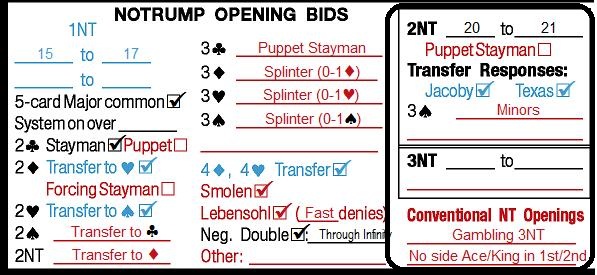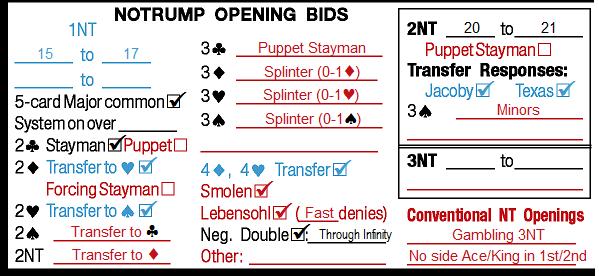

We can now finish the NOTRUMP OPENING BIDS section, with a slight breather. The right-hand most part of this section (see illustration) is not nearly as complicated nor memory-intensive as the other parts.
The 2NT opening should be 20-21 balanced. (With 18-19, open one of a suit and rebid by jumping to 2NT; with 22 or more balanced, start with 2 ). A five-card major is certainly possible, but I don't recommend using Puppet Stayman after 2NT (because it makes it hard to handle 5-4 in the majors).
). A five-card major is certainly possible, but I don't recommend using Puppet Stayman after 2NT (because it makes it hard to handle 5-4 in the majors).
Here is what I suggest you use after a 2NT opening:
3 : Regular Stayman
: Regular Stayman
3 /3
/3 : Transfers
: Transfers
3 : Minor-Suit Stayman
: Minor-Suit Stayman
3NT: To Play
4 : Gerber
: Gerber
4 /4
/4 : Texas Transfers
: Texas Transfers
4 : Does not Exist (though you can create a fancy meaning if you can remember it)
: Does not Exist (though you can create a fancy meaning if you can remember it)
4NT: Quantitative
Follow-ups: Very similar to after a 1NT opening.
After 2N-3 ;3
;3 : If you use Smolen after 1NT, then it applies here, too. If you don't use Smolen, then 3
: If you use Smolen after 1NT, then it applies here, too. If you don't use Smolen, then 3 /3
/3 in this auction would show 5 of that major and 4 of the other (GF).
in this auction would show 5 of that major and 4 of the other (GF).
After 2N-3 -3M: The other major is an artificial "raise" showing slam interest (example: 2N-3
-3M: The other major is an artificial "raise" showing slam interest (example: 2N-3 ;3
;3 -4
-4 =spade slam try).
=spade slam try).
Bidding 4-of-a-minor after using Stayman is natural (example: 2N-3 ;3any-4
;3any-4 =Clubs, forcing--the only way to show a club suit--the Stayman bidder need not have a major). Please, oh please, do not play this as Gerber. If you wish to ask for aces, you can bid the other major first to set trump, and then use 4NT to ask for aces. It is much more important to be able to naturally show clubs (via Stayman, then 4
=Clubs, forcing--the only way to show a club suit--the Stayman bidder need not have a major). Please, oh please, do not play this as Gerber. If you wish to ask for aces, you can bid the other major first to set trump, and then use 4NT to ask for aces. It is much more important to be able to naturally show clubs (via Stayman, then 4 ).
).
After a Jacoby Transfer: 3NT=Choice of games. Anything else after a Jacoby transfer is natural (a second suit). Jacoby followed by a raise to four is a mild slam try (because you can sign off in four via a direct Texas Transfer). Jacoby followed by 4NT is quantitative while Texas followed by 4NT is RKC (same structure as after 1NT).
If there is interference (unlikely), double is negative (not penalty). New suits are natural and forcing.
As you've heard me say before, there are definitely more modern and fancy possibilities, but not worth the trade-off of having to remember them.
3NT OPENING:
This should not be used to show a big balanced hand. Always start such strong hands with 2 (leaving more room). You can always rebid 3NT with the big balanced hand if need be.
(leaving more room). You can always rebid 3NT with the big balanced hand if need be.
This leaves several options for opening 3NT. One is to play it as a solid major (Kantar 3NT). Another is to play it as a 4-of-a-minor preempt (this works well in conjunction with NAMYATS--an option/upgrade to LC Standard).
Lastly, is what I recommend: GAMBLING. All that is promised is a long running suit (typically a minor, but it could be a major in 3rd- or 4th- seat). "Long and running" means at least AKQxxxx (yes, seven of them). In 1st and 2nd position, do not have any outside aces or kings. In 3rd or 4th position, anything goes (partner is supposed to pass your 3rd- or 4th- seat Gambling 3NT). Over a 1st- or 2nd- seat Gambling 3NT (no outside aces/kings), the responder will often remove to 4 or 5
or 5 to say: pass if you have clubs, convert to diamonds is you have diamonds.There are some fancy methods available after a Gambling 3NT, but I don't recommend memorizing them for the one time a year you'll use them.
to say: pass if you have clubs, convert to diamonds is you have diamonds.There are some fancy methods available after a Gambling 3NT, but I don't recommend memorizing them for the one time a year you'll use them.
I hope you've made it this far--NOTRUMP OPENING BIDS is the hardest part of LC Standard (or of most systems). It involves some memory and study (especially the Stayman follow-ups).
Here is the completely filled-out 1NT section for LC Standard:
Next month we move to MAJOR SUIT OPENING BIDS.
For a view of the entire LC Standard card and a prettier format of this series, see the "translation" at Bridge Winners.
Extra reading: